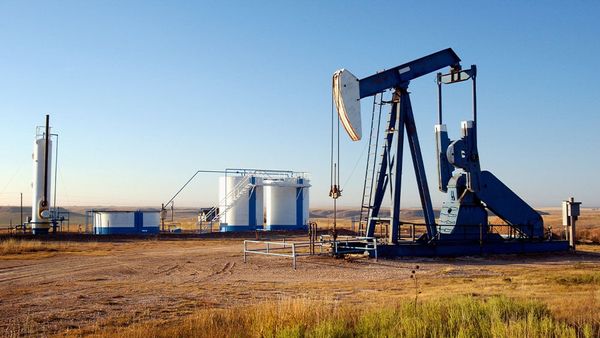Recent outlooks from Exxon Mobil and Chevron show both U.S. supermajors playing conservative, but clearly differentiated strategies next year as both work integrate recent $60 billion deals.
Investors in both Exxon Mobil stock and Chevron shares had a tough year in 2023. Oil markets turned lower after the Russia-Ukraine price spikes of 2022. And while the revival of hostilities in Gaza and Israel rattled the geopolitical world, it boosted oil prices for only a month. XOM traded 10% lower for the year as of Monday. Dow Jones component CVX was down nearly 20%.
Against that backdrop, last week, the two supermajors outlined their 2024 spending and operational plans. Exxon Mobil and Chevron set out cautious capital spending and production targets. Chevron targets a firm increase in oil output. Exxon's plan keeps production steady, while leaning on the added output from Pioneer for production growth.
Chevron and Exxon Mobil also enter 2024 after making mega deals in the latter part of 2023, which they got done without taking on any new debt. Exxon Mobil significantly expanded its Permian Basin holdings when it paid $60 billion for Pioneer Natural Resources in October. Chevron quickly followed up with its $53 billion purchase of Hess, bolstering its share of an Exxon-led project offshore from Guyana.
CFRA Research energy analyst Stewart Glickman told IBD the two supermajors have clean balance sheets at the moment and are "battle hardened" after experiencing oil prices unexpectedly falling apart, first in 2016, then again in 2020.
"They have both done a pretty good job of removing structural costs from their equation," Glickman said. "They're both likely to be conservative in 2024, at least when it comes to organic spending."
Exxon Mobil, Chevron And Oil Price Uncertainty
U.S. oil prices have recently hovered around $70 per barrel, down 25% from a September high and just below where they started the year.
Glickman sees oil prices as lower than they should be considering current geopolitics, including China's economic outlook and the Organization of Petroleum Exporting Countries (OPEC) latest production quota action. Those factors should lift oil prices to a 2024 average somewhere closer to $90 per barrel, Glickman says.
Fitch Ratings on Monday predicted 2024 would be a year of generally subdued oil prices. It expects Brent oil, which typically runs at a premium to U.S. crude, to average a moderate $80 per barrel. The rating agency also believes weak global growth in 2024 could prompt further OPEC+ cuts if the oil market shifts decisively into oversupply.
Third Bridge analyst Peter McNally expects an uncertain year, with Brent crude trading in the range of $70-$95 per barrel in 2024.
"If things do fall apart, (Exxon Mobil and Chevron) are probably going to be in better shape this time around than they were a decade ago," Glickman said.
Exxon Mobil Outlook
Last week, Exxon Mobil outlined $23 billion-$25 billion in capital spending and exploration expenses for 2024. XOM projects annual capex to jump to $22 billion-$27 billion annually from 2025 through 2027, driven by the company's carbon-cutting aspirations.
At the end of 2022, Exxon Mobil forecast annual capital expenditures at between $20 billion and $25 billion through 2027. Exxon's recent update said the company remained on track to complete $17.5 billion in share repurchases in 2023. That puts it halfway through its $35 billion repurchase program plotted out for 2023 and 2024.
XOM said it would increase the 2024 portion of that plan after the merger with PXD closes, and "assuming reasonable market conditions." The new target would be $20 billion annually through 2025.
Oil Production To Remain Flat
Exxon Mobil expects to produce about 3.8 million oil-equivalent barrels of oil and gas per day in 2024, rising to about 4.2 million oil-equivalent barrels per day by 2027, driven by growth in the Permian Basin and Guyana. Those numbers do not include output from PXD.
Meanwhile, analysts expect XOM's 2023 production to be 3.73 million barrels of oil equivalent per day, according to FactSet. Wall Street forecasts 4.13 million barrels of oil equivalent per day in 2024.
"It's not like they're going after production," Glickman said. "They're really trying to be quite thoughtful about not pushing the pedal too hard in short cycle plays. The way they're pushing it really is, in this case, inorganic through Pioneer."
Analyst project Pioneer will produce 745,000 oil-equivalent barrels per day for 2024. That would represent about a 20% overall production increase for Exxon. But it would mean only a minimal change for the overall oil market, keeping industry supply largely stable, and placing upward pressure on prices.
Analysts also predict Exxon Mobil's 2024 EPS will drop more than 30% compared to 2022 levels to $9.63. Revenue in 2024 is projected to contract 11% vs. 2022 to $367.99 billion.
XOM Increases Carbon Cutting Spending
Exxon Mobil plans more than $20 billion in spending on lower-emissions opportunities through 2027. That's up from an initial $3 billion in projects identified in early 2021. This is in addition to Exxon Mobil's 2023 carbon capture bet, the $5 billion purchase of Denbury. That deal provides the oil giant with a 1,300-mile-long pipeline dedicated to transporting carbon dioxide.
Exxon Mobil expects no return on investment from its "low carbon solutions" segment through 2027, McNally says. However, the Denbury purchase shows Exxon positioning to take advantage of federal subsidies. The August 2022 Inflation Reduction Act (IRA) boosted the per-ton federal tax credit for captured carbon emissions to $85, a 70% rise from the previous credit. For carbon scrubbed directly from the atmosphere, the IRA provides $180 a ton directly to the facility operator, creating a significant cash flow where no market had existed.
Exxon Mobil also announced plans to begin producing lithium, the key component for EV batteries, by 2027. The oil and petrochemicals heavyweight also aims to become the leading lithium supplier for electric vehicles by 2030. The goal entails production of enough lithium to supply the manufacture of more than 1 million EVs per year.
XOM is not the only U.S. energy giant eying EV diversification. In July, Chevron Chief Executive Mike Wirth told Bloomberg the company was also looking into lithium. In early October, Chevron Technology Ventures, the oil company's venture capital arm, invested in Electric Era, a high-speed EV charging startup.
Chevron Outlook: Increases Spending After Megadeal
Meanwhile, Chevron plans to raise its capital spending in 2024. It targets global expenditures in a range of $18.5 billion to $19.5 billion, up 11% from $17 billion in 2023, according to its Dec. 6 corporate plan. This increase in capital spending comes as CVX shelled out $53 billion for Hess and purchased PDC Energy for $6.3 billion in 2023.
After the Hess acquisition, Chevron also predicts capital spending will run at between $19 billion and $22 billion a year through 2027. That's up from its pre-Hess forecast of $14 billion -$16 billion. Wall Street forecasts CVX's 2024 earnings totaling $14.46 per share, down 23% compared to 2022, with sales dropping 15% to $201 billion.
Chevron expects 2024 upstream spending to be about $14 billion, with two-thirds of that allocated to the U.S., including around $5 billion for Chevron's Permian Basin development.
CVX expects downstream capital expenditures to be roughly $1.5 billion, with 80% bookmarked for the U.S. Meanwhile, Chevron added it has about $2 billion in spending for "lower carbon" projects, in line with 2023 levels.
"We're maintaining capital discipline in both traditional and new energies," Chevron Chief Executive Mike Wirth said in the Dec. 6 announcement.
Analysts also see Chevron's production around 3.55 million barrels of oil equivalent per day in 2024, up 14% compared to the 2023 expectation.
Please follow Kit Norton on X, formerly known as Twitter, @KitNorton for more coverage.
YOU MAY ALSO LIKE:
Get An Edge In The Stock Market With IBD Digital
Labor Unions Keep The Heat On Starbucks And Amazon
Learning How To Pick Great Stocks? Read Investor's Corner
Market Looks Ready To Run; 5 Stocks In Buy Zones As Tesla Sets Up










